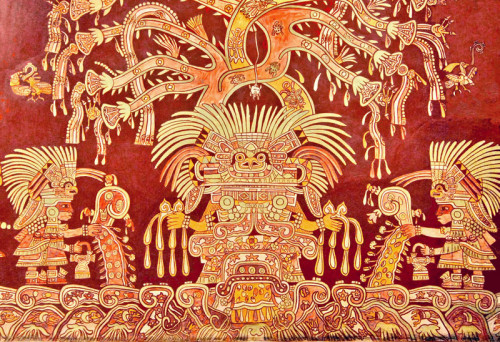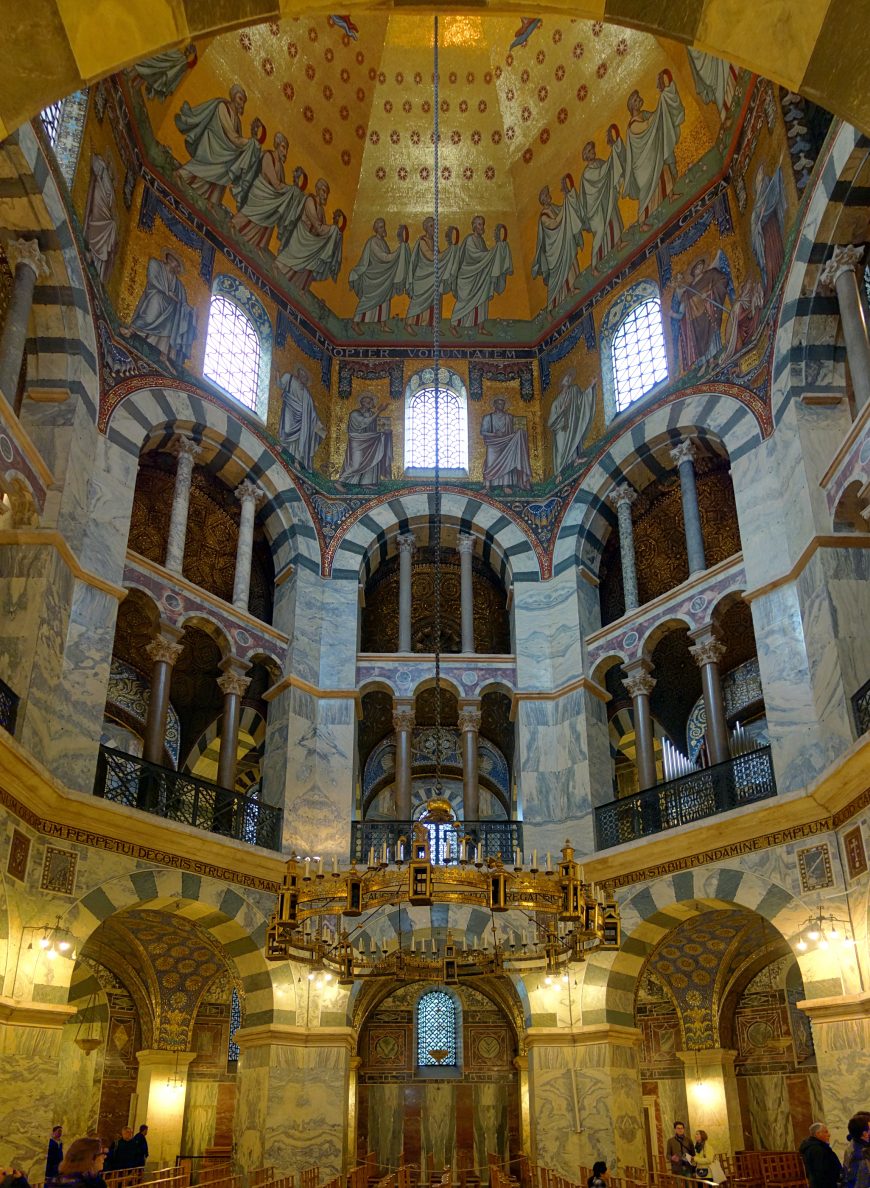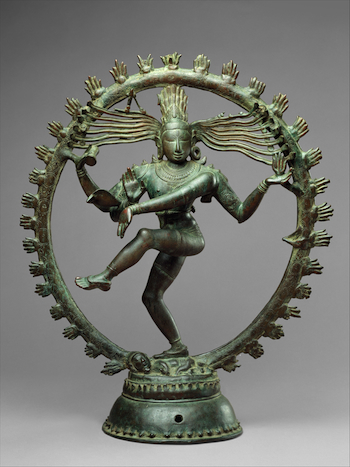Introduction to Artistic Spirituality
My theme for my art exhibition is the concept and
importance of spirituality within separate cultures. This theme incorporates
death and the afterlife, as well as aspects of religion. This is because
separate cultures can incorporate religious meaning into spirituality. The
first piece I have chosen for my exhibition is the “Haniwa Warrior”. These statues are depictions of warriors either
with armor or without, and they are placed outside of tombs or burials. Their
specific function isn’t known, only guessed, mainly because there wasn’t a
system of writing in Japan at the time of their existence (c. 250 to c. 600
CE). However, they are thought to be the guardians of tombs and burial mounds
of this era. Moving on, the second piece that I am going to be exhibiting is “Shiva as Lord of the Dance (Nataraja)”. This
statuette is a depiction of the Hindu god Shiva. Shiva is the God of
Destruction in Hinduism. This statuette depicts her as the Lord of Dance. The
purpose of this statue is largely thought to be for processional parades.
Priests would carry statues like these and bless whoever came to the parade. The
third piece of work I am presenting is the mural of multiple elements from the
Teotihuacan people. This piece of art originates from South America. This mural
incorporates many different elements into it, with people and different
deities. Next, I will be looking at the “Puerta
del Sol” or “Gateway to the Sun”. This
gateway is thought to have astrological significance and is a part of the
Tiwanaku culture in South America. My final selection is the Palatine Chapel in
Aachen. This giant chapel depicts multiple aspects of the Christian religion
and goes in depth with the significance of the afterlife. In total, all of
these different pieces of art that come from multiple cultures all tie into each
respective culture’s spiritual identity. Whether it be religious in nature, or
completely independent from any form of religion, they all pertain to the soul,
and the meaning in death or the afterlife.
 The reconstruction of the mural depicting the Goddess of Teotihuacan is
a part of a larger collection of murals in the compound of Tepantitla in
Teotihuacan that are thought to be from 100 BCE – 700 CE. The reconstruction of
this piece currently resides in the National Museum of Anthropology in Mexico
City. The goddess depicted in this mural is very specific to Teotihuacan, and
for a long time she was believed to be a god of rain and warfare. However, in
1974, a man named Peter Furst proposed the idea that the god in the mural was actually
a goddess, a feminine deity. Researcher Esther Pasztory also believed that she
was a vegetation and fertility goddess, due to the accompanying figures and themes
within the mural. The Great Goddess is often shown in a generous nature, as
below her in the mural, mortals seem to dance, play ball, and swim in the water
that drips from her hands up above. On top of the Great Goddess, what appears
to be growing out of her head is thought to be hallucinogenic vines, or perhaps
even the world tree, which has roughly the same meaning as most other cultures;
it is the tree that spreads across the universe and gives meaning in every
action. The Great Goddess of Teotihuacan has not been seen in areas outside of
Teotihuacan, other than where members of this culture have settled, which has
lead researchers to believe that this goddess was merely a predecessor for
Chalchiuhtlicue, an Aztec goddess associated with water and fertility.
The reconstruction of the mural depicting the Goddess of Teotihuacan is
a part of a larger collection of murals in the compound of Tepantitla in
Teotihuacan that are thought to be from 100 BCE – 700 CE. The reconstruction of
this piece currently resides in the National Museum of Anthropology in Mexico
City. The goddess depicted in this mural is very specific to Teotihuacan, and
for a long time she was believed to be a god of rain and warfare. However, in
1974, a man named Peter Furst proposed the idea that the god in the mural was actually
a goddess, a feminine deity. Researcher Esther Pasztory also believed that she
was a vegetation and fertility goddess, due to the accompanying figures and themes
within the mural. The Great Goddess is often shown in a generous nature, as
below her in the mural, mortals seem to dance, play ball, and swim in the water
that drips from her hands up above. On top of the Great Goddess, what appears
to be growing out of her head is thought to be hallucinogenic vines, or perhaps
even the world tree, which has roughly the same meaning as most other cultures;
it is the tree that spreads across the universe and gives meaning in every
action. The Great Goddess of Teotihuacan has not been seen in areas outside of
Teotihuacan, other than where members of this culture have settled, which has
lead researchers to believe that this goddess was merely a predecessor for
Chalchiuhtlicue, an Aztec goddess associated with water and fertility.
 The Palatine Chapel in
Aachen is a large religious chapel that was dedicated to Jesus Christ and the
Virgin Mary by Pope Leo III. It is unknown exactly when it was constructed, but
the palace was dedicated in a ceremony in 805 CE, five years after Charlemagne
was promoted to Holy Roman Emperor. The chapel covers a large area in Aachen
and is the town’s major landmark. The chapel is full of depictions of angels
and Christ himself throughout the interior of the dome and the walls up above.
It is also thought by some historians that Charlemagne placed his marble throne
beneath the central depiction of Christ to create a visual link between him and
Jesus Christ. Apart from being dedicated to Christ and the Virgin Mary,
Charlemagne himself was interred here, and the building was used for coronation
ceremonies after his death – well into the 16th century.
The Palatine Chapel in
Aachen is a large religious chapel that was dedicated to Jesus Christ and the
Virgin Mary by Pope Leo III. It is unknown exactly when it was constructed, but
the palace was dedicated in a ceremony in 805 CE, five years after Charlemagne
was promoted to Holy Roman Emperor. The chapel covers a large area in Aachen
and is the town’s major landmark. The chapel is full of depictions of angels
and Christ himself throughout the interior of the dome and the walls up above.
It is also thought by some historians that Charlemagne placed his marble throne
beneath the central depiction of Christ to create a visual link between him and
Jesus Christ. Apart from being dedicated to Christ and the Virgin Mary,
Charlemagne himself was interred here, and the building was used for coronation
ceremonies after his death – well into the 16th century.
Haniwa Warrior
This is an example of a “Haniwa Warrior” which was often found near funerary sites or tombs in Japan.
These warriors originated in Japan at a time where there was no writing system
(c. 250 to c. 600 CE). This particular piece originates from the late Tumulus
period (c. 500-600 CE) and it’s dimensions are 31 x 14 3/8 x 15 inches / 78.7 x
36.5 x 38.1 cm. The purpose of these statues are debated but ultimately
unknown. It is believed that these warriors were used as landmarks for sacred
tombs and burial sites, but their location wouldn’t have been easily accessible
to visitors, so it remains debated if their purpose was one that was spiritual
in nature, or simply territorial. These haniwa,
as they are known, spread further and further, peaking at the height of the
Kofun period (c. 400-500 CE), and the tombs that they accompanied are also
thought to be testimonies to the power of the state with the authority to compel
other smaller states. In addition, many haniwa
were not human in nature, and began to gradually transform into other
simpler states (such as vases or containers), or animal-like forms (one such
example being a haniwa in the shape
of a horse head).
Shiva as Lord of the Dance (Nataraja)
Shiva as Lord of the Dance (Nataraja)
is a mobile statue that is Hindu in nature, and it depicts the Goddess of
Destruction, Shiva, as a Lord of the Dance, or Nataraja. This copper-alloy statue is thought to be from the 11th
century and is 68.3 cm x 56.5 cm, and its creator is unknown. What is
known about this statue is that it was intended to be moveable and hoisted on a
shoulder. Beginning in the 11th century, Hindu devotees would carry this
statue and statues like it through processional parades, followed by other priests
chanting prayers and blessings to any that would gather for this occasion.
During procession, statues may be adorned in gold and other fine cloth and
jewelry so as to denote the human form as lesser than that of the Hindu gods.
It is believed that when a devotee comes to pray to Shiva, faith activates the
divine energy within and allows Shiva to be present at that very moment. Shiva
plays a large role in the artistic influence of art in India and other Hindu
occupied regions. Art for the most part was largely focal towards religion and
connecting one’s faith to a physical manifestation of a god or gods. Looking closely
at the statue, one noticeable feature is that Shiva holds the damaru, an artifact of importance in
Hindu religion that signifies the passage of time and is syncopated with the
act of creation.
The Great Goddess of Teotihuacan

Puerta del Sol in Tiwanaku
La Puerta del Sol, meaning "The Gateway to the Sun" in Spanish, is a large arch-like object that is currently in Bolivia. This statue was made sometime between c. 300 - 1000 CE, and was
made by the Tiwanaku culture. The object is about 9.8 feet tall and 13 feet wide,
and made of stone. There are multiple carvings on the stone which were
originally thought to be mystical or spiritual in nature, but are now also
believed that they have an astronomical importance, and may have served a
calendrical purpose. The object is carved with 48 squares that surround a
central figure. Each square contains a character that is depicted as a winged
effigy. In total, there are 32 effigies with human like faces and there are 16
effigies that are thought to be condors. These effigies all look towards a man
with his head surrounded by 24 rays of light, which may represent the multiple
rays of the sun. Some historians and archeologist believe that the staves that the
figure is holding represent thunder and lightning, and that he might also be
the Sun God. Likewise, other archeologists have linked this figure with the
Inca God, Viracocha, who happens to be a creator deity in Inca mythology. In
any case, there is deeper meaning within these figures and carvings that have
yet to be untapped.
The Palatine Chapel in Aachen
 The Palatine Chapel in
Aachen is a large religious chapel that was dedicated to Jesus Christ and the
Virgin Mary by Pope Leo III. It is unknown exactly when it was constructed, but
the palace was dedicated in a ceremony in 805 CE, five years after Charlemagne
was promoted to Holy Roman Emperor. The chapel covers a large area in Aachen
and is the town’s major landmark. The chapel is full of depictions of angels
and Christ himself throughout the interior of the dome and the walls up above.
It is also thought by some historians that Charlemagne placed his marble throne
beneath the central depiction of Christ to create a visual link between him and
Jesus Christ. Apart from being dedicated to Christ and the Virgin Mary,
Charlemagne himself was interred here, and the building was used for coronation
ceremonies after his death – well into the 16th century.
The Palatine Chapel in
Aachen is a large religious chapel that was dedicated to Jesus Christ and the
Virgin Mary by Pope Leo III. It is unknown exactly when it was constructed, but
the palace was dedicated in a ceremony in 805 CE, five years after Charlemagne
was promoted to Holy Roman Emperor. The chapel covers a large area in Aachen
and is the town’s major landmark. The chapel is full of depictions of angels
and Christ himself throughout the interior of the dome and the walls up above.
It is also thought by some historians that Charlemagne placed his marble throne
beneath the central depiction of Christ to create a visual link between him and
Jesus Christ. Apart from being dedicated to Christ and the Virgin Mary,
Charlemagne himself was interred here, and the building was used for coronation
ceremonies after his death – well into the 16th century. What does this all mean?
Although not everything can be concretely tied to religion or spirituality, perceiving something with a fresh pair of eyes allows us to break down what each and every artistic depiction can mean. The creators aren't here to ask, so we are left to our own thoughts and interpretations. The deeper meaning in these examples provides questions and thoughts about spirituality that may lead towards a deeper understanding of how we have evolved artistically in our depictions and references to religion and life.



No comments:
Post a Comment